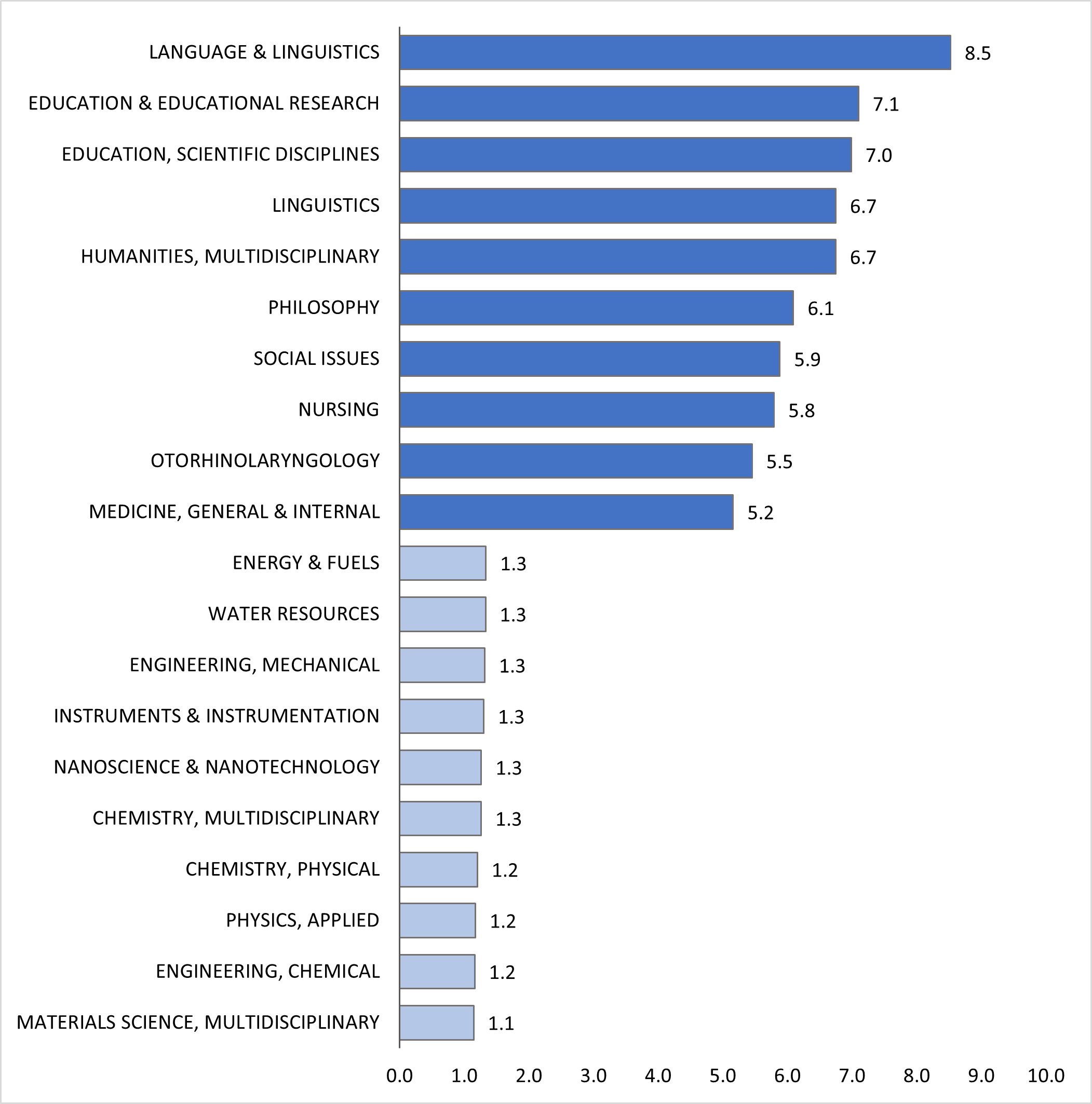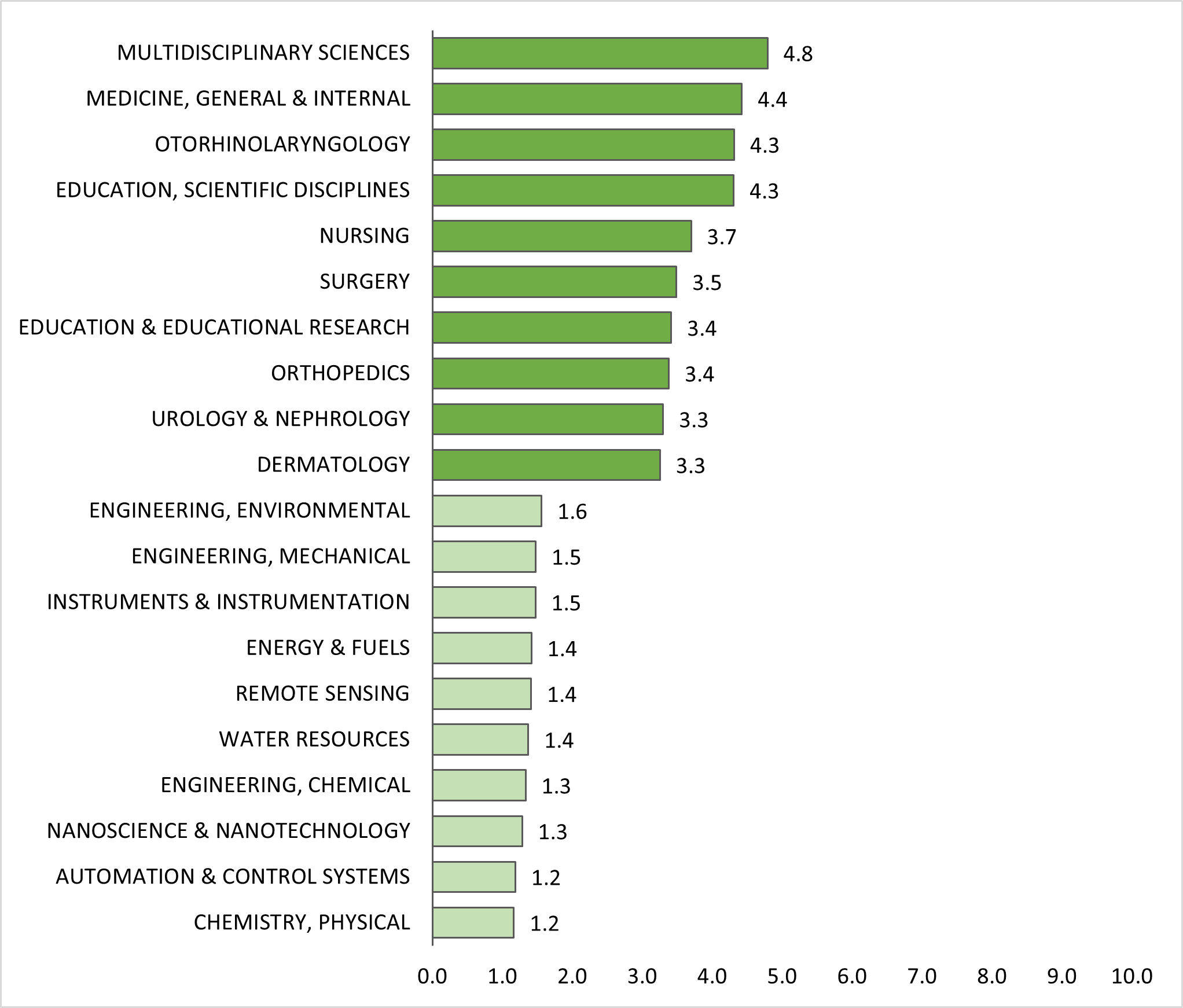Artificial intelligence (AI) is increasingly becoming an integral part of scientific research. Many publications across various fields now examine AI-related topics, including methodological innovations, technical applications, ethical considerations, and policy discussions. The number of these publications has grown rapidly, especially since the public release of advanced large language models such as OpenAI’s ChatGPT in late 2022. This rapid increase in scholarly publications raises an important question: Do AI-related publications attract greater academic attention, as measured by citations, than comparable research in the same fields and journals? This essay explores that question by analyzing recent AI-related publications and their performance on field- and journal-normalized citation indicators, as well as by discussing the potential reasons for this citation advantage and the challenges it presents for the research community.
Evidence of Citation Advantage
To investigate the citation impact of AI-related research, a dataset of 44,640 publications (including research articles, reviews, editorials, and letters) published between 2023 and 2024 was compiled from the Web of Science Core Collection. Each publication’s title included at least one AI-related keyword (e.g., Artificial Intelligence, AI, LLM, ChatGPT, GPT). The citation performance of these publications was evaluated using two field-normalized indicators from Clarivate’s InCites Benchmarking & Analytics platform. The Category Normalized Citation Impact (CNCI) measures a publication’s citations relative to the global average for its subject category, publication type, and year.1 Similarly, the Journal Normalized Citation Impact (JNCI) compares a publication’s citations with those of similar papers published in the same journal and year.2 In both metrics, a value of 1.0 represents the expected average, while values above 1.0 indicate above-average impact, and values below 1.0 indicate below-average impact.
The dataset’s median CNCI was 2.2, meaning AI publications received more than twice the expected number of citations within their respective subject areas. Similarly, the median JNCI of 1.9 indicates nearly double the citation impact compared to other papers in the same journals. Both median CNCI and JNCI values were significantly higher than the baseline of 1.0 (Wilcoxon signed-rank test, P < 0.001). This pattern was consistent across most disciplines: 94% of research areas for CNCI (231/246) and 95% for JNCI (233/246) exceeded the benchmark. AI-related studies achieved higher than expected citation rates not only in traditionally high-impact domains such as engineering, clinical medicine, and biology and biochemistry, but also in low-citation fields including literature, arts, and humanities. For example, the median CNCI values were 8.5 in language and linguistics, 7.1 in education and educational research, and 6.1 in philosophy. Figures 1 and 2 present the top and bottom 10 research areas with the highest and lowest median CNCI and JNCI values for AI-related publications. Overall, these findings indicate that the citation advantage of AI publications is not driven by a small number of highly cited papers but rather reflects a broad and consistent pattern of above-average impact across nearly all fields of research.


Limitations of the Dataset
This analysis is based on publications with titles that include at least one AI-related keyword. As a result, the dataset contains a broad range of AI-related scholarly outputs, including research articles, reviews, editorials, and letters that discuss, critique, or apply AI concepts. This approach may capture publications that address AI in a thematic rather than methodological sense, such as those focusing on ethical, educational, or policy perspectives rather than studies that use AI as a research tool or technique. Therefore, the findings should be interpreted as representing the citation performance of AI-related publications in general, rather than strictly AI-driven research. The analysis also focuses on publications from 2023 to 2024, offering an early snapshot of post-ChatGPT trends. Although using normalized indicators (CNCI and JNCI) helps reduce the effect of limited citation windows, future analyses could determine whether the observed citation advantage remains consistent over time.
Reasons for Citation Advantage of AI-Related Publications
Multiple factors likely contribute to the citation advantage of AI-related publications. First, AI research is highly multidisciplinary, spanning diverse domains such as computer science, biomedicine, education, information science, law, and the social sciences. This multidisciplinary nature allows AI-related publications to reach wider academic audiences. As previous research has shown,3 multidisciplinary studies generally receive greater attention and achieve higher citation impact. Second, AI tools, models, and methods are highly transferable across disciplines. Algorithms, datasets, and analytical frameworks originally developed for one purpose can often be adapted to new contexts with minimal modifications. This adaptability increases both the visibility and reusability of AI-related work and enhances the likelihood of being cited by researchers in various fields. Third, the fast-evolving nature of AI research provides a temporal advantage in citation accumulation. The field’s ongoing updates and innovations encourage scholars to cite the newest work, leading AI publications to receive citations more quickly than those in slower-developing disciplines.
Fourth, AI has become a popular and widely discussed topic not only in academia but also in the media, industry, and government. This broad cross-sector interest means that AI-related studies are more frequently discussed and shared, which expands their societal reach and scholarly impact. Fifth, substantial investments in AI from governments, funding bodies, and industry partners have elevated its visibility. Previous studies show that research supported by major grants or prestigious funders tend to be more widely disseminated and cited.4 Sixth, AI concepts and applications are increasingly integrated into education and professional training. Foundational studies, key methodological papers, and important case studies are now commonly included in university curricula, workshops, and training programs across various fields. This educational integration increases the likelihood that both students and instructors cite these works in their own research. Finally, the academic publishing industry itself has increased attention to AI. Many journals now feature special issues or dedicated sections on AI-related themes, and major conferences have established AI-focused tracks and workshops. By clustering related papers together, these venues enhance the discoverability of new research and increase the likelihood that multiple studies within the same issue or session will be cited together.
Challenges and Risks Behind the Citation Advantage of AI-Related Publications
The factors that contribute to the citation success of AI-related publications also may create significant challenges for the scientific community. Maintaining research quality, methodological rigor, and ethical standards has become more difficult as the number of AI-related publications continues to rise. The rapid publication of studies on trending AI topics can overload peer review systems and lead to a large number of repetitive or low-quality papers. Recent evidence shows a noticeable increase in low-value papers in some fields following the introduction of generative AI tools.5 Once published, these papers often gain further visibility through citations, even though their scholarly value remains limited. Another concern involves the distortion of citation practices and journal metrics. The substantial influence of AI-related research may encourage opportunistic behaviors, such as including superficial AI-related keywords in titles or abstracts to attract attention even when the content is not genuinely about AI. Journals may also prioritize AI-related submissions in anticipation of higher citation counts and Impact Factor gains. Such practices can artificially inflate citation indicators and distort the validity of metrics used to evaluate research impact and journal performance.
A further issue concerns equity and balance in scholarly attention. As academic interest, funding, and citations increasingly concentrate on AI-related topics, other important fields risk being neglected. This imbalance can narrow the diversity of research agendas and reduce the visibility of high-quality work in less prominently cited areas. Finally, from an ethical and societal standpoint, the rapid pace of AI development enables early or speculative studies to attract substantial attention and shape policy, public debate, and research agendas, even when robust empirical evidence is lacking. This situation raises the risk of premature or poorly informed decisions in both policy and public domains.
Conclusion
In summary, AI-related publications show a clear and substantial citation advantage across a wide range of fields and journals. On average, these publications are cited nearly twice as often as comparable research, as confirmed by both field-normalized and journal-normalized indicators. This citation benefit likely reflects a combination of factors, including the multidisciplinary nature of AI research, the transferability of its methods and tools, the novelty and visibility of AI topics, greater funding and institutional support, integration into education and training, and increased editorial and public attention. At the same time, this citation advantage raises concerns about research quality, fairness, and long-term sustainability. Ensuring that this growing impact does not compromise scholarly integrity or distort research indicators and priorities will require efforts among researchers, institutions, and publishers.
Disclosures
All aspects of the study, including conceptualization, data collection and analysis, interpretation of results, and writing, were carried out by the sole author. The draft was reviewed and improved using Grammarly to increase readability. The author reviewed the final version and accepted full responsibility for the content and integrity of the work. The author states that there are no conflicts of interest related to this work. The dataset created for this research is available upon reasonable request.
References and Links
- https://incites.zendesk.com/hc/en-gb/articles/25087312115601-Category-Normalized-Citation-Impact-CNCI
- https://incites.zendesk.com/hc/en-gb/articles/25087351508241-Journal-Normalized-Citation-Impact-JNCI
- Cai X, Lyu X, Zhou P. The relationship between interdisciplinarity and citation impact—a novel perspective on citation accumulation. Humaniti Soc Sci Comm. 2023;10(1):1–12. https://doi.org/10.1057/s41599-023-02475-3.
- Dorta-González P, Dorta-González MI. Citation differences across research funding and access: funded articles tend to receive 50% more citations than unfunded ones. J Acad Librarianship. 2023;49:102734. https://doi.org/10.1016/j.acalib.2023.10273.
- Naddaf M. AI linked to explosion of low-quality biomedical research papers. Nature. 2025;641:1080–1081. https://doi.org/10.1038/d41586-025-01592-0
Amin Erfanmanesh, PhD (https://orcid.org/0000-0002-1843-0012), is an independent researcher, New Brunswick, Canada.
Opinions expressed are those of the authors and do not necessarily reflect the opinions or policies of their employers, the Council of Science Editors, or the Editorial Board of Science Editor.
